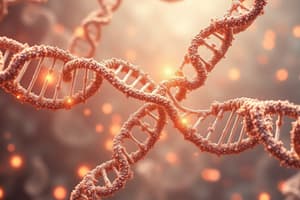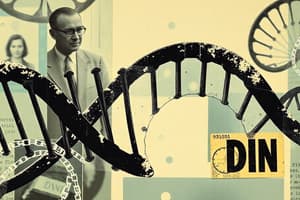Podcast
Questions and Answers
Is DNA replication described as conservative or semi-conservative? What does that mean?
Is DNA replication described as conservative or semi-conservative? What does that mean?
DNA replication is described as semi-conservative. This means that each new DNA double-helix strand contains one strand of the original parent strand.
What are the 3 parts of a nucleotide?
What are the 3 parts of a nucleotide?
Nitrogenous base, phosphate, sugar (deoxyribose for DNA)
The pyrimidine bases are?
The pyrimidine bases are?
Thymine and cytosine
The purine bases are?
The purine bases are?
Is DNA replication a catabolic or anabolic process?
Is DNA replication a catabolic or anabolic process?
What is the starting point in replication called?
What is the starting point in replication called?
Which strand is synthesized towards the replication fork?
Which strand is synthesized towards the replication fork?
What type of bond does helicase break?
What type of bond does helicase break?
What is at the 5' end of DNA? What about the 3' end?
What is at the 5' end of DNA? What about the 3' end?
Function of helicase?
Function of helicase?
Function of primase?
Function of primase?
Function of polymerase?
Function of polymerase?
Ligase function?
Ligase function?
Which of the base pairs would be harder to split? Why?
Which of the base pairs would be harder to split? Why?
Which of the strands (leading or lagging) would use more RNA primer? Why?
Which of the strands (leading or lagging) would use more RNA primer? Why?
Flashcards are hidden until you start studying
Study Notes
DNA Replication Overview
- DNA replication is semi-conservative, with each new double-helix containing one original parent strand.
- It is characterized as an anabolic process since it builds new DNA strands.
Nucleotide Structure
- A nucleotide consists of three components: nitrogenous base, phosphate group, and deoxyribose sugar.
Nitrogenous Bases
- Pyrimidine bases include thymine (T) and cytosine (C).
- Purine bases consist of adenine (A) and guanine (G).
DNA Replication Mechanics
- The starting point for replication is called the Point of Origin.
- Helicase is responsible for unzipping the DNA helix by breaking the hydrogen bonds between nitrogen bases.
Strand Synthesis
- The lagging strand is synthesized towards the replication fork, requiring more RNA primers due to its synthesis occurring in the opposite direction.
- The leading strand is synthesized continuously.
Key Enzymes and Their Functions
- Helicase: Unzips the double helix.
- Primase: Lays down RNA primers for DNA polymerase to follow.
- Polymerase: Adds free-floating nucleotides to synthesize the new DNA strand.
- Ligase: Glues nucleotides together on the lagging strand.
Base Pairing Strength
- Guanine (G) and cytosine (C) pairs are harder to split than adenine (A) and thymine (T) pairs due to G and C forming three hydrogen bonds, compared to the two hydrogen bonds in A and T.
5' and 3' Ends
- DNA strands have a 5' end with a phosphate group and a 3' end with a hydroxyl group.
Studying That Suits You
Use AI to generate personalized quizzes and flashcards to suit your learning preferences.




